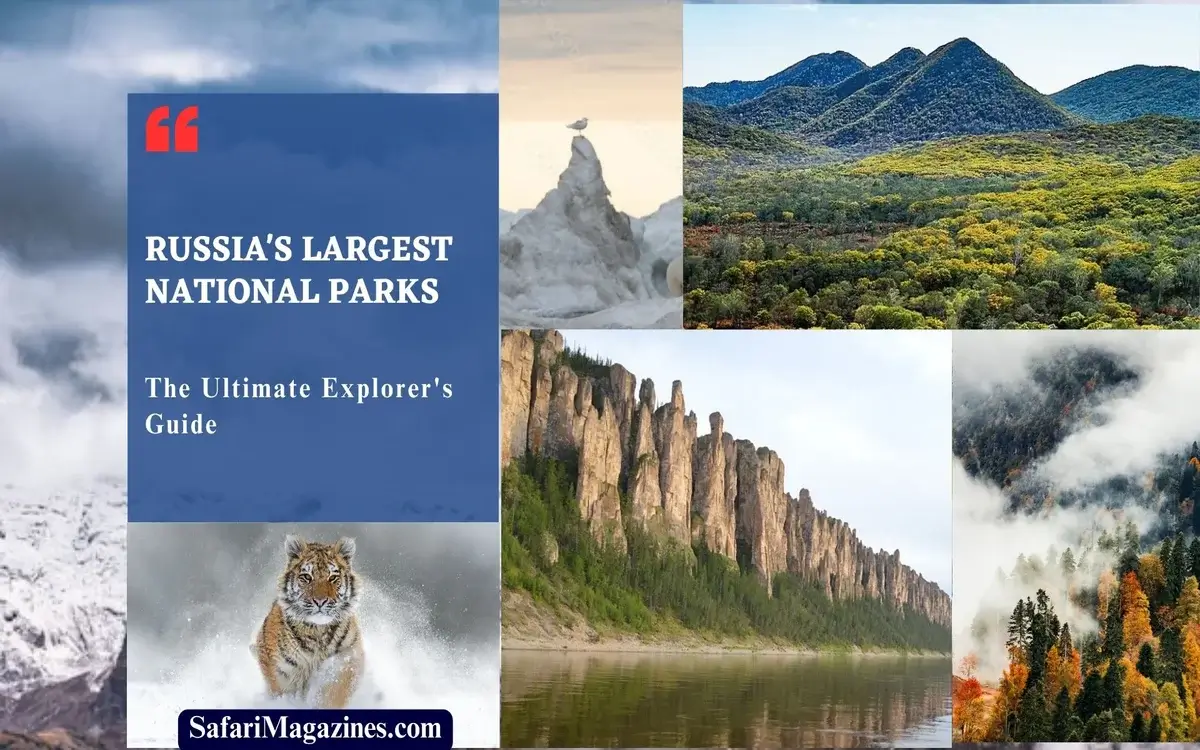
Russia’s Largest National Parks, The Ultimate Explorer’s Guide. Russia is the largest country on the world. It has large cities and a rich history, and it also has some of the most stunning natural areas. Amid its vast spaces lie treasures of environmental importance – its national parks. These protected areas are home for many animals and plants, offering a insight into the beauty of wildlife.
Table of Contents
ToggleCriteria of Selection
The criteria for selecting the Russia’s national parks are based on several factors, including:
- Size and Importance: Let’s pick the big players, the parks that really stand out in Russia. We want ones that cover vast areas, have unique ecosystems, and are rich in all kinds of plant and animal life.
- Diversity of Landscapes: We need parks that offer a little bit of everything. Mountains, forests, lakes, rivers, coastlines—you name it. So, this way, visitors get a taste of Russia’s incredible natural diversity.
- Iconic Wildlife: Think about the animals that make Russia’s parks famous. We want parks that are home to the big names—the tigers, the bears, the eagles. Those are the ones that really draw people in.
- Cultural and Historical Significance: Let’s not forget about the human side of things. Parks with a rich history, ancient ruins, or ties to indigenous communities add another layer of interest and meaning.
- Accessibility: It’s important that people can actually get to these parks without too much trouble. Whether it’s by road, train, or even a short flight, accessibility means more people can experience the wonders of nature.
- Conservation Efforts: We want parks that are doing their part to protect the environment.
- Tourism Infrastructure: A good visitor experience is key. Parks with well-marked trails, informative visitor centers, and maybe even some cozy lodges or campsites make it easier for people to connect with nature.
- Sustainability Initiatives: Let’s make sure these parks are looking out for the long term. So, from recycling programs to eco-friendly practices, sustainability shows a commitment to preserving these natural treasures for future generations.
Exploring the Vastness: Russia’s Landscape
Russia’s terrain is as diverse as it is expansive, ranging from the icy tundra of the Arctic to the dense forests of Siberia and the towering peaks of the Caucasus Mountains. So, preserving these landscapes is not just a matter of aesthetic appreciation; it’s a crucial step in safeguarding our planet’s biodiversity.
Understanding National Parks
National parks play an important role in conservation efforts around the world. They are specific areas where nature prevails, allowing ecosystems to flourish without disrupting human development. So, these parks act as living laboratories for scientists, providing invaluable insights into ecological processes.
Continue reading: Russia’s Largest National Parks: The Ultimate Explorer’s Guide
The Magnificence of Russia’s Largest National Parks
Among Russia’s vast collection of national parks, several stand out for their sheer size and ecological significance. These parks not only preserve pristine landscapes but also harbor unique species found nowhere else on Earth.
Beringia National Park: Preserving a Frozen Landscape
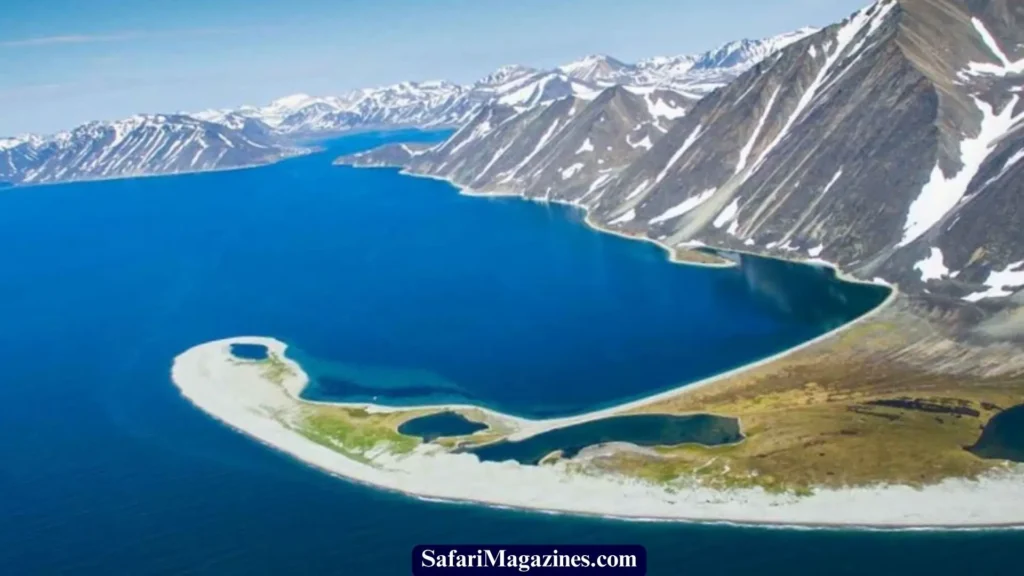
Beringia National Park is a frozen wonderland located in the remote northeastern regions of the country. This national park is considered the largest national park in Russia, holding the title since 2013. It was named after the ancient land bridge that once connected Asia and North America during the last Ice Age. So, Beringia serves as a vital corridor for the migration of plants and animals, promoting biodiversity in a harsh environment. This park also tells us about the resilience of Arctic wildlife. The park’s frozen areas are also home to indigenous peoples who have lived in this land for thousands of years. Their traditional way of life is closely aligned with the rhythms of the natural world.
Visitors to Beringia National Park enjoy an unforgettable experience, with opportunities for wildlife viewing, hiking and cultural exchange. Also, guided tours led by local experts provide insight into the park’s ecology and indigenous cultures, providing a deeper understanding of this remote place
Best Time to Visit
- June to August.
The best time to visit Beringia National Park is during the summer months, from June to August, when temperatures are milder and daylight lasts nearly 24 hours. This is prime time for wildlife viewing and outdoor activities, such as hiking and camping. However, visitors should be prepared for unpredictable weather and should dress warmly, even in the summer months.
Wildlife of Animals and Plants:
- Wildlife Animals: Reindeer, Musk Oxen, Arctic Foxes, Migratory Birds.
- Plants: Hardy species adapted to the Arctic climate, such as Dwarf Willows, Arctic Poppies, and Mosses.
How to Get There
- Accessible by boat or helicopter from remote northeastern Russia.
Access to Beringia National Park is limited, as it is located in a remote and largely uninhabited region of northeastern Russia. The nearest major city is Anadyr, which can be reached by air from Moscow or other major Russian cities. So, from Anadyr, visitors can arrange transportation to the park via charter plane, helicopter, or boat, depending on the season and weather conditions.
Limits and Restrictions
- Due to its remote location and fragile ecosystem, Beringia National Park has strict limits and restrictions on visitor access.
- Permits may be required for entry, and certain areas of the park may be off-limits to protect sensitive wildlife habitats.
- Visitors are also required to follow Leave No Trace principles and to respect the park’s Animals and plants.
- Follow designated trails.
- Respect indigenous cultures.
Recommendations
- Dress in layers and prepare yourself for changing weather conditions, even in the summer months.
- Bring plenty of food, water, and supplies, as there are limited amenities in the park.
- Hire a local guide or join a guided tour to learn more about the park’s ecology and indigenous cultures.
- Explore untouched wilderness areas.
- Respect wildlife and observe from a distance, refraining from feeding or approaching animals.
- Practice Leave No Trace principles and pack out all trash to help preserve the park’s pristine wilderness.
- Take some time to enjoy the beauty of these Arctic regions and consider the importance of preserving these ecosystems for future generations.
Continue reading: Russia’s Largest National Parks: The Ultimate Explorer’s Guide
Yugyd Va National Park: Nature’s Haven
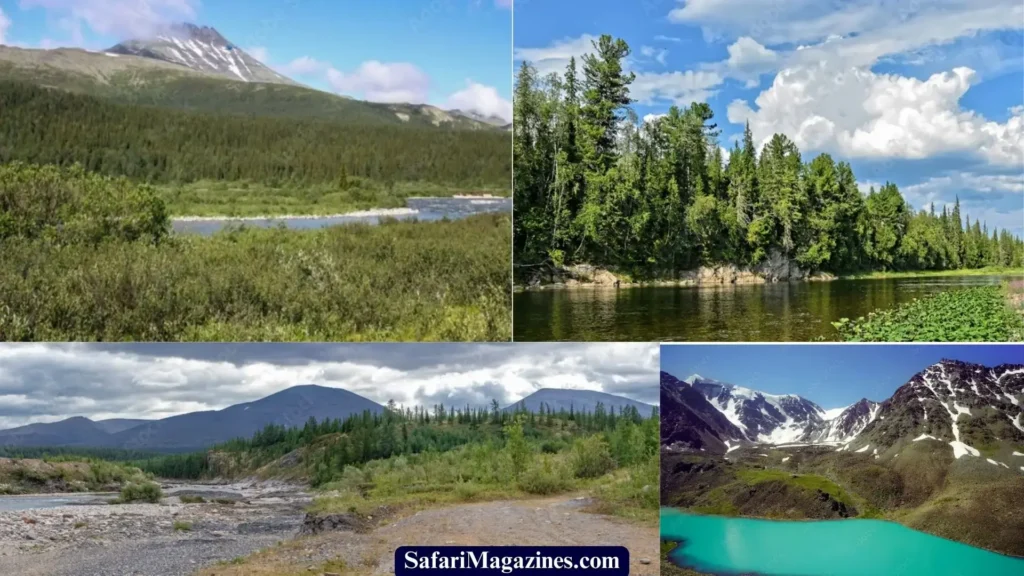
Yugyd Va National Park is located in the rugged Ural Mountains, Russia. This National park is Europe’s largest national park. It is bigger than Vatnajökull National Park in Iceland. It extends over an area of 19,200 sq-km. In this place, surrounded by tall mountains and winding rivers, visitors can relax in the nature, away from the noise of city life. The park is home to the indigenous Mansi people, whose ancestors have lived on these lands for many generations. Therefore, visitors can also explore ancient sacred sites and archaeological wonders, and learn about the rich traditions that have shaped this land for centuries. As a result, Yugyd Va National Park is a hidden gem waiting to be explored.
Best Time to Visit:
- During the summer months, from June to August.
The best time to visit Yugyd Va National Park is during the summer months, from June to August, when the weather is mild and the plants is in full bloom. This is also the perfect time for hiking and wildlife watching.
Wildlife of Animals and Plants:
- Wildlife Animals: Siberian brown bear, Reindeer, Musk oxen, Arctic foxes, Golden eagle, Migratory birds.
- Plants: Towering conifers, delicate wildflowers.
How to Get There:
- Accessible by boat or helicopter from remote northeastern Russia.
- The most common way to reach Yugyd Va National Park is by flying into the city of Perm and then taking a combination of buses and taxis to the park entrance. From there, visitors can explore the park on foot or by hiring a local guide.
Limits and Restrictions:
- Visitors must obtain a permit from the park authorities before entering the park.
- Some areas may be off-limits to protect sensitive habitats and wildlife, so it’s important to follow all posted signs and regulations.
- Follow designated trails.
- Respect indigenous cultures.
Recommendations:
- When visiting Yugyd Va National Park, be sure to bring plenty of warm clothes, as temperatures can be cold even in the summer months.
- It’s a good idea to bring a sturdy pair of hiking boots, plenty of water, and snacks for your adventures in the wilderness.
- Don’t forget your camera, you’ll want to capture every moment of this unforgettable journey into the heart of Russia’s wilderness.
- Explore pristine wilderness areas.
- Learn about indigenous heritage.
Zapovedniks: Russia’s Strict Nature Reserves
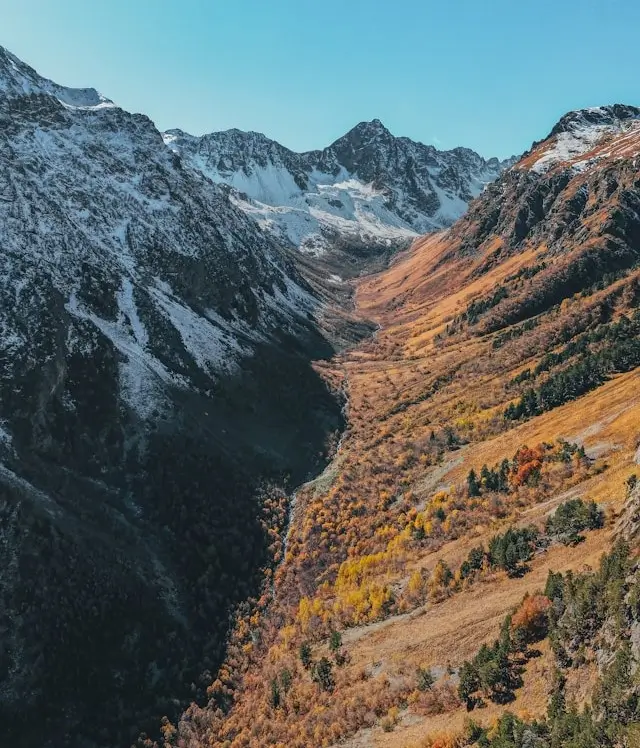
At the zenith of protection are Russia’s Zapovedniks, or strict nature reserves. Its area more than 8,000 sq.-km. These areas are limited only to the necessary scientific studies. So, this offers a safe place for endangered animals and sensitive environments.
Best Time to Visit:
- Varies by location, typically during the summer months.
The best time to visit Zapovedniks varies depending on the region and its climate. Generally, summer months provide ideal conditions for exploration, with milder temperatures and longer daylight hours. However, certain reserves may offer unique opportunities for winter activities such as snowshoeing and wildlife tracking.
Wildlife of Animals and Plants:
- Wildlife Animals: Varied depending on the specific Zapovednik, may include rare and endangered species, Siberian tiger to the elusive snow leopard
- Plants: Forests, meadows, and wetlands providing countless species of plants and flowers.
How to Get There:
- Accessible by car, train, or boat depending on the location of the Zapovednik
Access to Zapovedniks can vary depending on their location and remoteness. Some reserves may be accessible by road, while others require more adventurous means of transportation such as hiking, horseback riding, or even helicopter access. It’s essential to research each reserve’s accessibility and plan your visit accordingly.
Limits and Restrictions:
- Strict conservation regulations, limited access to protect sensitive ecosystems
- As strict nature reserves, Zapovedniks impose strict limits and restrictions on visitor activities to minimize human impact on the environment.
- Activities such as camping, fishing, and hunting are typically prohibited, and visitors are expected to stick to designated trails and observation areas.
- Entry may be limited to certain times of the year or require special permits.
Recommendations:
- When visiting Zapovedniks, it’s essential to come prepared for outdoor exploration.
- Be sure to bring appropriate clothing, shoes, and supplies for hiking and wildlife viewing.
- Respect the rules and regulations of each reserve, and remember that your actions can have a significant impact on the delicate ecosystems you are visiting.
- Join guided tours led by park rangers.
- Learn about ongoing conservation efforts.
- Take the time to enjoy in the natural beauty of these protected areas.
Continue reading: Russia’s Largest National Parks: The Ultimate Explorer’s Guide
Lake Baikal National Park: Jewel of Siberia
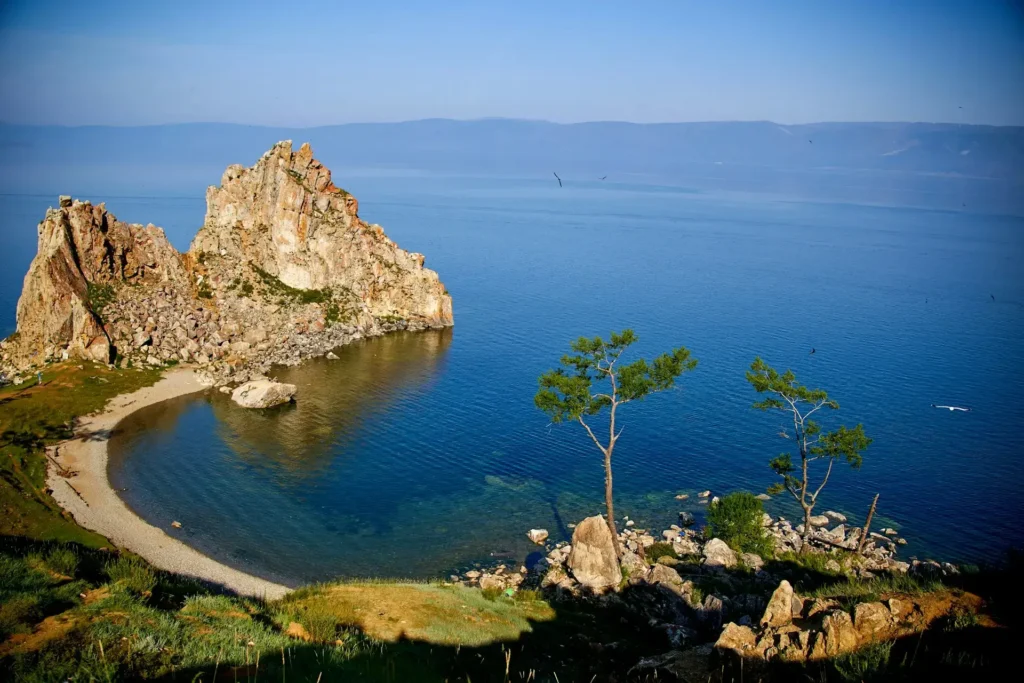
Nestled in the heart of Siberia, Lake Baikal is not only the world’s deepest lake but also home to a remarkable array of endemic species. The surrounding national park protects this natural wonder, ensuring its preservation for generations to come.
Best Time to Visit:
- During the summer months from June to August
The best time to visit Lake Baikal National Park is during the summer months from June to August when the weather is mild, and outdoor activities like hiking and boating are most enjoyable.
Wildlife of Animals and Plants:
- Baikal seal, Siberian brown bear, Siberian musk deer, Siberian tiger, Baikal oil fish, and endemic fish species.
How to Get There:
- Accessible from Irkutsk by train or ferry
Lake Baikal National Park is accessible by train or bus from Irkutsk, the nearest major city. From Irkutsk, visitors can take a scenic drive along the Baikal Highway or hop on a ferry to Olkhon Island, the largest island in Lake Baikal.
Limits and Restrictions:
- Visitors to Lake Baikal National Park should stick to designated trails and follow park rules to minimize their impact on the delicate ecosystem.
- Swimming in Lake Baikal is allowed but be cautious of cold water temperatures, even in summer.
Recommendations:
- Don’t miss the opportunity to explore Olkhon Island, known for its dramatic landscapes and spiritual significance.
- Take a boat tour to the stunning rock formations of Cape Khoboy or hike to the top of Shaman Rock for panoramic views of the lake.
Wrangel Island: A Haven for Arctic Wildlife
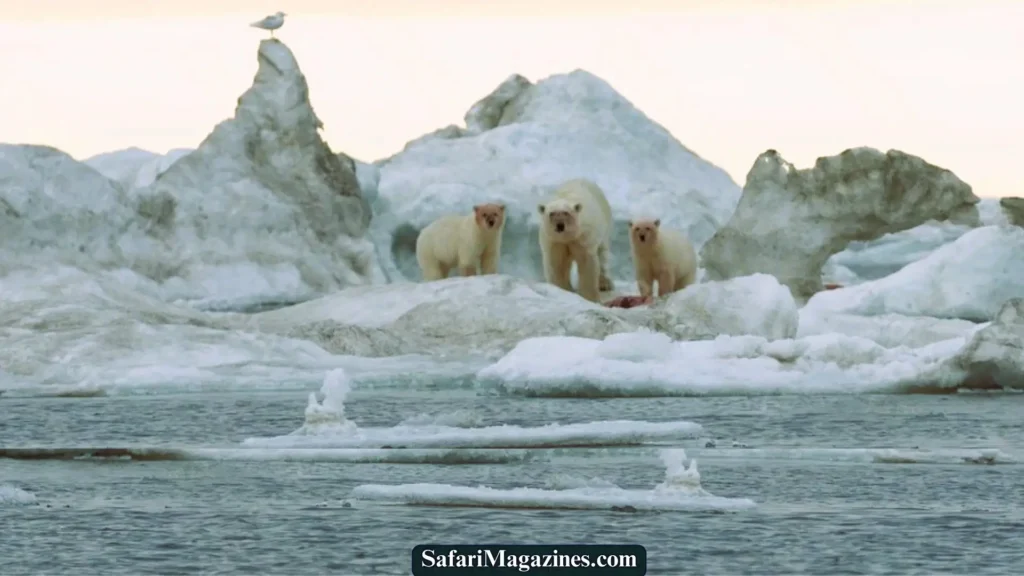
Far to the north, Wrangel Island stands as a symbol to the resilience of Arctic life. This remote place provides a breeding ground for polar bears, walruses and countless migratory birds. So, this makes it an important site for conservation efforts.
Best Time to Visit:
- During the summer months from July to August.
The best time to visit Wrangel Island is during the summer months from July to August when the sea ice has melted, and the island is teeming with life.
Wildlife of Animals and Plants:
- Wildlife Animals: Polar bears, Walruses, Arctic foxes, Migratory birds such as snow geese and ivory gulls.
- Plants: Colorful wildflowers.
How to Get There:
- Join specialized expedition cruises from Anadyr or Nome.
Access to Wrangel Island is limited and typically requires joining a specialized expedition cruise departing from Russia’s Far East. These cruises depart from ports such as Anadyr or Nome, Alaska, and offer guided tours of the island’s wildlife and landscapes.
Limits and Restrictions:
- Restricted access, guided tours required
- Due to its remote location and sensitive environment, access to Wrangel Island is strictly regulated, and visitors must be accompanied by experienced guides at all times.
- Some places of the island may be off-limits to protect nesting seabirds and other sensitive habitats.
Recommendations:
- Visit the historic remains of Wrangel Island’s abandoned settlements, which offer a glimpse into the island’s storied past as a refuge for Arctic explorers and indigenous peoples.
- Take a Zodiac cruise along the island’s rugged coastline for up-close encounters with walruses and other marine mammals.
Continue reading: Russia’s Largest National Parks: The Ultimate Explorer’s Guide
Lena Pillars Nature Park: The Ancient Guardians
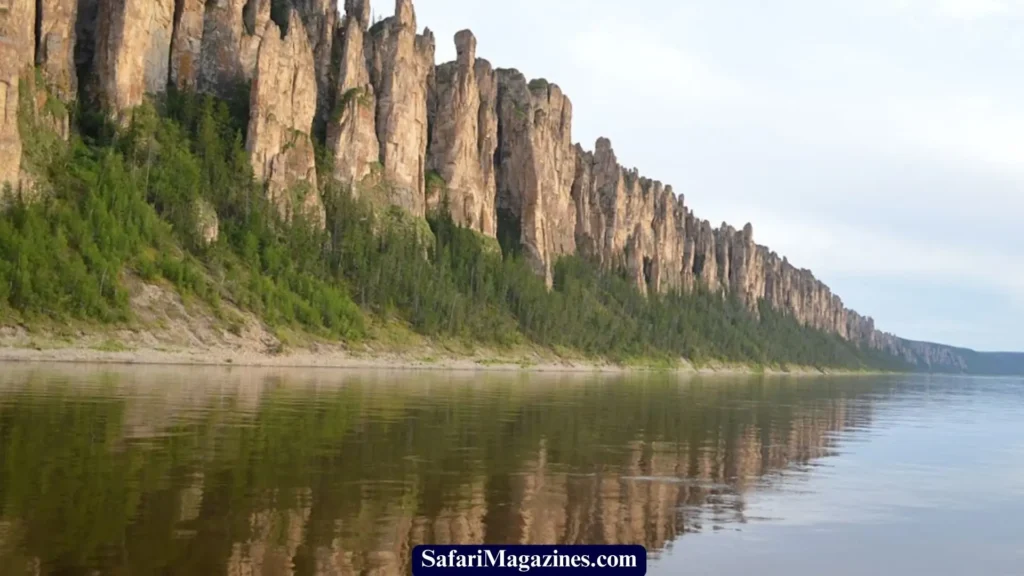
Carved by the ebb and flow of ancient rivers, the Lena Pillars are a symbol to the power of nature’s sculpting hand. Its covering an area more than 12,750 sq-km. The UNESCO World Heritage Site is a geological marvel, and also holds deep cultural significance for the indigenous peoples of Siberia
Best Time to Visit:
- June to August
The best time to visit Lena Pillars Nature Park is during the summer months from June to August when the weather is warmest, and the Lena River is navigable.
Wildlife of Animals and Plants:
- Animals: Siberian chipmunk, Siberian weasel, Migratory birds.
- Plants: Wildflowers.
How to Get There:
- Accessible by boat or helicopter from Yakutsk
Lena Pillars Nature Park is accessible by boat or helicopter from the city of Yakutsk, the capital of Russia’s Sakha Republic. For example, boat tours along the Lena River offer stunning views of the park’s iconic rock formations and opportunities for wildlife spotting.
Limits and Restrictions:
- While exploring Lena Pillars Nature Park, visitors are encouraged to stay on designated trails and respect the park’s fragile ecosystems.
- Certain areas of the park may be inaccessible during the winter months when the Lena River is frozen.
- No campfires
Recommendations:
- Take a river cruise: Go on a multi-day river cruise along the Lena River, stopping at scenic viewpoints and riverside villages along the way.
- witness the midnight sun: Don’t miss the chance to witness the midnight sun illuminating the Lena Pillars in the summer months, creating a surreal spectacle of light and shadow.
Ergaki Nature Park: Siberia’s Hidden Gem

Tucked away in the Sayan Mountains, Ergaki Nature Park offers a haven for outdoor enthusiasts seeking solace in the wilderness. This National parks covers 3,450 sq-km. It has jagged peaks, crystal-clear lakes and dense forests. So, this makes it a good place for hiking, climbing and for nature lovers as well.
Best Time to Visit:
- June to September
The best time to visit Ergaki Nature Park is during the summer months from June to September when the weather is mild, and the hiking trails are accessible.
Wildlife of Animals and Plants:
- Animals: Siberian ibex, Altai snowcock, Siberian stone pine.
- Plants: Dense forests, Rare Rozzy-flowers.
How to Get There:
- Ergaki Nature Park is accessible by car from the city of Krasnoyarsk, the largest city in Russia’s Siberian region.
- The park’s main entrance is located near the village of Yelovka, where visitors can obtain trail maps and information about park regulations.
Limits and Restrictions:
- Stay on designated trails: While exploring Ergaki Nature Park, visitors are encouraged to stay on designated trails and avoid disturbing wildlife habitats.
- No campfires: Camping is allowed in designated areas, but campfires are prohibited to reduce the risk of forest fires.
Recommendations:
- Hike to Mount Ergaki: Hike to the summit of Mount Ergaki for panoramic views of the surrounding mountains and valleys.
- Explore alpine lakes: Don’t miss the opportunity to explore the park’s alpine lakes, which offer refreshing swimming and fishing opportunities during the summer months.
Land of the Leopard National Park: Preserving the Big Cats
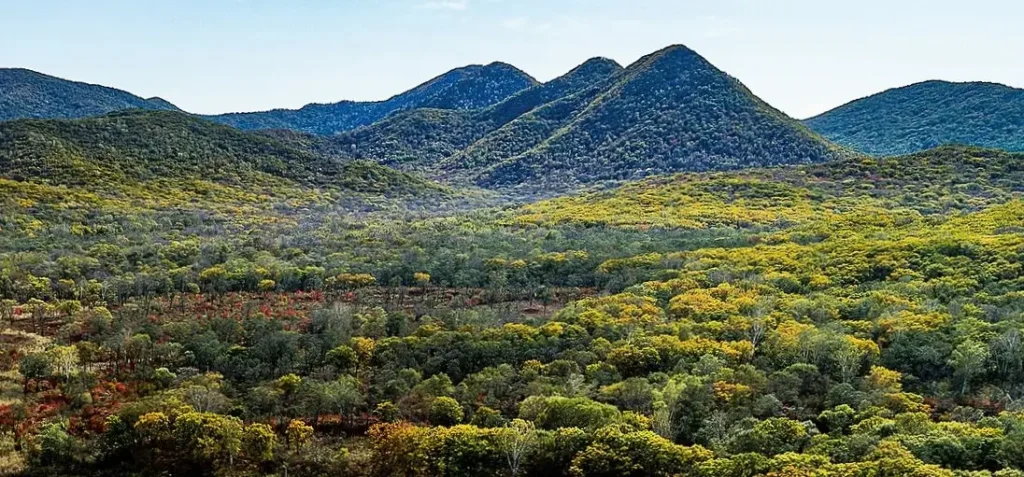
In the rugged terrain of Primorsky Krai, the Land of the Leopard National Park stands as a sign of hope for the critically endangered Amur leopard. So, through dedicated conservation efforts, this park aims to secure a future for these magnificent big cats.
Best Time to Visit:
- Spring and autumn
The best time to visit Land of the Leopard National Park is during the spring and autumn months when the weather is mild, and wildlife activity is at its peak.
Wildlife of Animals and Plants:
- Animals: Amur leopard, Siberian tiger, Far Eastern leopard cat, Manchurian sika deer, Amur goral, and Asiatic black bear.
- Plants: Amur flower
How to Get There:
- Accessible by car or public transportation from Vladivostok
Land of the Leopard National Park is accessible by car or public transportation from the city of Vladivostok, the largest city in Russia’s Far East. The park’s main entrance is located near the village of Barabash, where visitors can obtain trail maps and information about park regulations.
Limits and Restrictions:
- Respect wildlife habitats: Due to the sensitive nature of the park’s ecosystem, access to certain areas may be restricted to protect wildlife habitats.
- Follow designated trails: Visitors are encouraged to stay on designated trails and avoid disturbing wildlife or littering.
Recommendations:
- Join a guided wildlife tour, led by experienced park rangers for the best chance of spotting Amur leopards and other rare species.
- Visit research center: Don’t miss the opportunity to visit the park’s dedicated research and education center, where visitors can learn about conservation efforts to protect the region’s endangered big cats.
Continue reading: Russia’s Largest National Parks: The Ultimate Explorer’s Guide
Curonian Spit National Park: Where Dunes Meet Forests
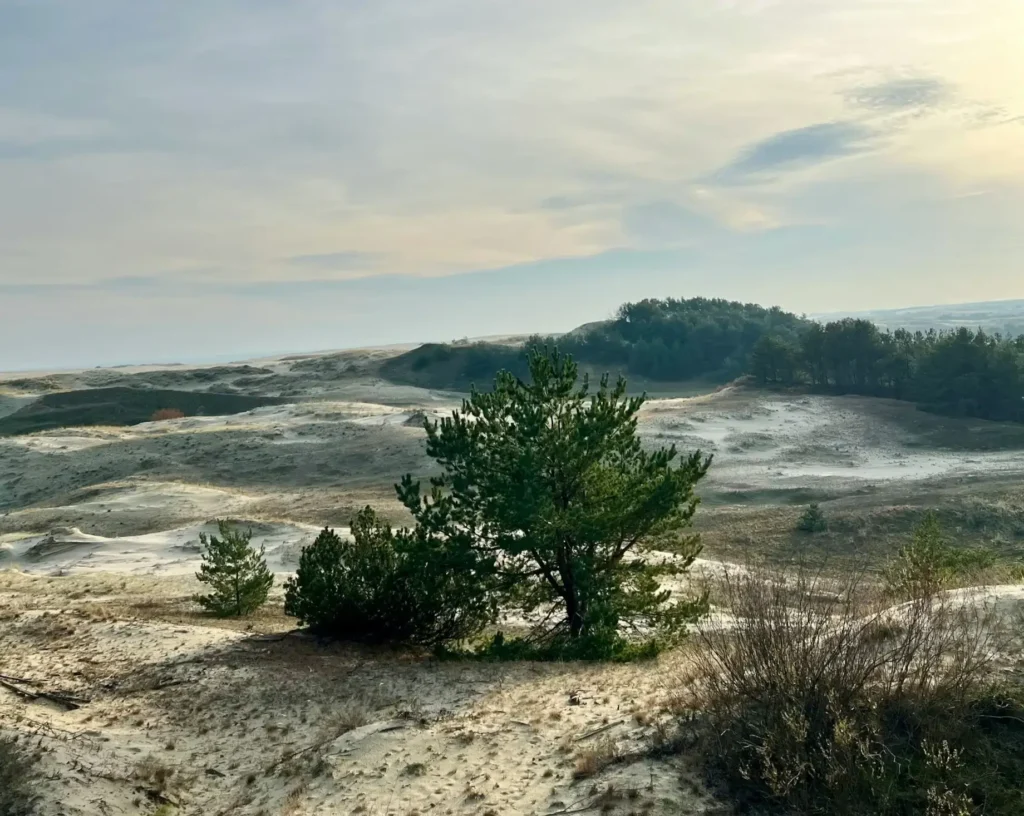
Stretching along the Baltic Sea coast, the Curonian Spit is a landscape of unparalleled beauty. Its moving sand dunes show how powerful the winds and waves can be, while its green forests are home to many plant and animal species.
Best Time to Visit:
- June to August
The best time to visit Curonian Spit National Park is during the summer months from June to August when the weather is warmest, and the dunes are most accessible.
Wildlife of Animals and Plants:
- Animals: European bison, Gray wolf, Wildflowers
- Plants: European pine marten along the park’s hiking trails and beaches.
How to Get There:
- Accessible by car or public transportation from Kaliningrad
Curonian Spit National Park is accessible by car or public transportation from the city of Kaliningrad, the administrative center of Russia’s Kaliningrad Oblast. The park’s main entrance is located near the town of Nida, where visitors can obtain trail maps and information about park regulations.
Limits and Restrictions:
- Stay on designated trails,: While exploring Curonian Spit National Park, visitors are encouraged to stay on designated trails and respect the park’s fragile coastal ecosystems.
- Protect nesting seabirds: Certain areas of the park may be off-limits to protect nesting seabirds and other sensitive habitats.
Recommendations:
- Climb Parnidis Dune: Climb to the top of the Parnidis Dune for panoramic views of the Curonian Lagoon and the surrounding pine forests.
- Explore fishing villages: Don’t miss the opportunity to explore the park’s quaint fishing villages and sample traditional Lithuanian cuisine at local restaurants.
Central Sikhote-Alin: Wilderness of Primorsky Krai
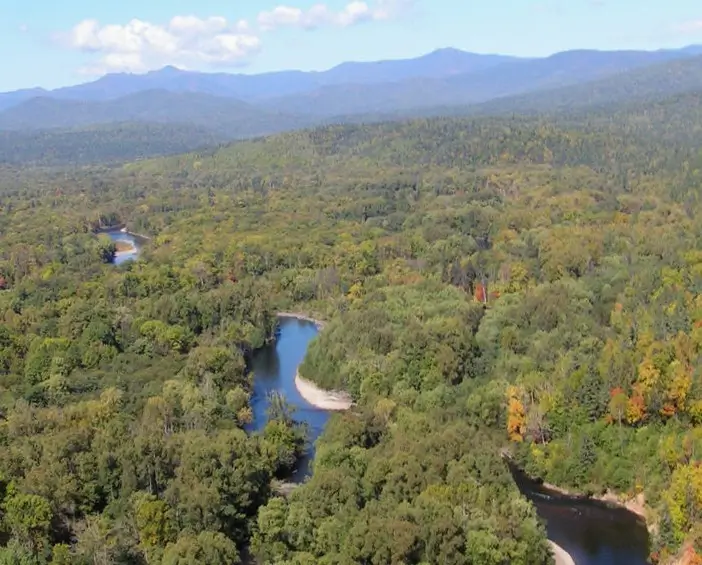
In the remote reaches of Primorsky Krai, the Central Sikhote-Alin is a wilderness untouched by time. Here, rare species such as the Siberian tiger roam free, their presence a reminder of the fragile balance of nature.
Best Time to Visit:
- June to August
The best time to visit Central Sikhote-Alin is during the summer months from June to August when the weather is warmest, and wildlife activity is at its peak.
Wildlife of Animals and Plants:
- Animals and Plants: Siberian tiger, Amur leopard, Asiatic black bear.
- Plants: Primorsky Krai oil flower.
How to Get There:
- Accessible by car or public transportation from Vladivostok
Central Sikhote-Alin is accessible by car or public transportation from the city of Vladivostok, the largest city in Russia’s Far East. The park’s main entrance is located near the village of Terney, where visitors can obtain trail maps and information about park regulations.
Limits and Restrictions:
- Respect wildlife habitats: Due to the sensitive nature of the park’s ecosystem, access to certain areas may be restricted to protect wildlife habitats.
- Follow designated trails: Visitors are encouraged to stay on designated trails and avoid disturbing wildlife or littering.
Recommendations:
- Join a guided wildlife tour led by experienced park rangers for the best chance of spotting Siberian tigers and other rare species.
- Visit research center: Don’t miss visiting the park’s dedicated research and education center. For example, in this center, visitors can learn about efforts to preserve endangered wildlife in the region.
Continue reading: Russia’s Largest National Parks: The Ultimate Explorer’s Guide
Kronotsky Biosphere Nature Reserve: Land of Fire and Ice
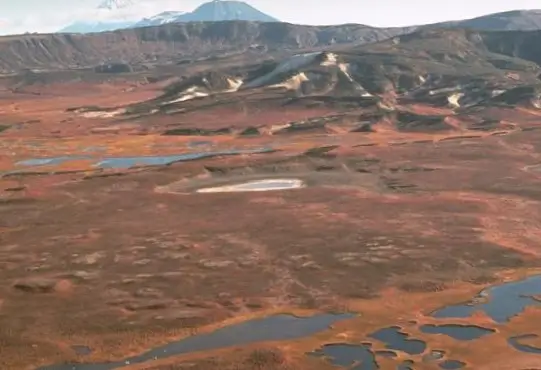
Kronotsky Biosphere Reserve is located on the Kamchatka Peninsula, Russia. Its covers an area more than 11,000 sq-km. The stunning scenery of this nature reserve, with the steam vents of its volcanic calderas and the icy peaks of its snow-capped mountains, makes it a land of opposites. Additionally, its rugged beauty has drawn explorers and scientists alike to its remote corners for research and discovery.
Best Time to Visit:
- June to August
The best time to visit Kronotsky Nature Reserve is during the summer months from June to August when the weather is warmest, and the wildlife is most active.
Wildlife of Animals and Plants:
- Animals and Plants: Brown bear, Steller’s sea eagle, Kamchatka marmot
- Plants: Kronotsky tree
How to Get There:
- Accessible by helicopter or boat from Petropavlovsk-Kamchatsky
Kronotsky Nature Reserve is accessible by helicopter or boat from the city of Petropavlovsk-Kamchatsky, the administrative center of Russia’s Kamchatka Krai. So, access to the reserve is strictly regulated, and visitors must obtain permits in advance from the reserve’s headquarters in Petropavlovsk-Kamchatsky.
Limits and Restrictions:
- Restricted access: Due to the sensitive nature of the reserve’s ecosystem, access to certain areas may be restricted to protect wildlife habitats.
- Visitors are required to be accompanied by experienced guides at all times and follow strict Leave No Trace principles to minimize their impact on the environment.
- Permits required.
Recommendations:
- Take a scenic flight over the Valley of Geysers for a bird’s-eye view of this otherworldly landscape.
- Visit hot springs: Don’t miss the opportunity to swim in the natural hot springs of Lake Kronotsky, where you can relax and enjoy stunning views of the Kamchatka Peninsula.
Sochi National Park: Where the Mountains Kiss the Sea
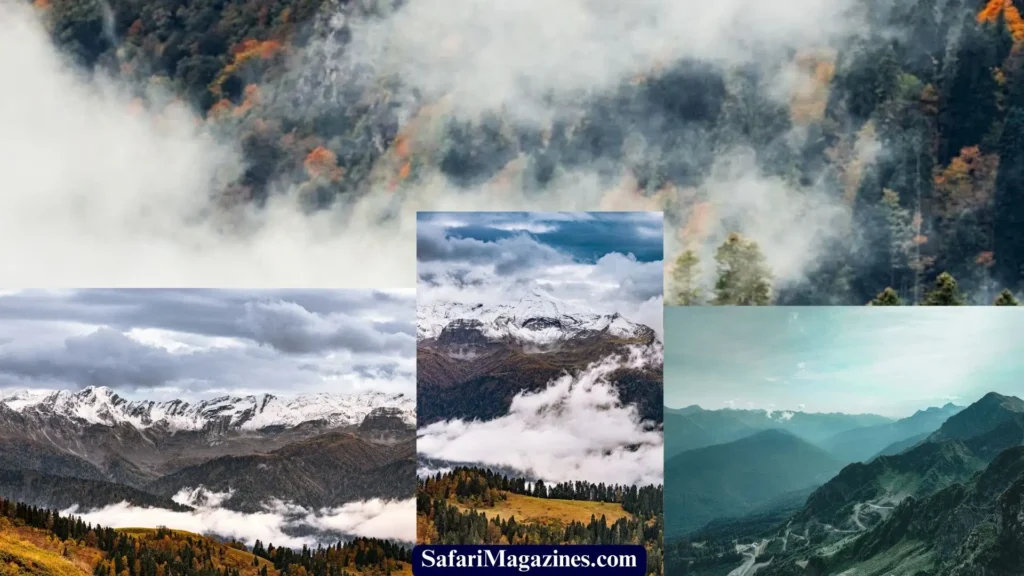
Sochi National Park is located between the Caucasus Mountains and the Black Sea. It extends over an area of more than 2,000 sq-km. This national park contains lush forests, alpine meadows and coastal wetlands, and is home to a large number of plant and animal life.
Best Time to Visit:
- June to August
The best time to visit Sochi National Park is during the summer months from June to August when the weather is warmest, and outdoor activities like hiking and swimming are most enjoyable.
Wildlife of Animals and Plants:
- Animals: Caucasian red deer, Caucasian tur, European badger.
- Plants: Coastal flora
How to Get There:
- Accessible by car or public transportation from Sochi
Sochi National Park is accessible by car or public transportation from the city of Sochi, the largest city in Russia’s Krasnodar Krai. The park’s main entrance is located near the village of Khosta, where visitors can obtain trail maps and information about park regulations.
Limits and Restrictions:
- Stay on designated trails: While exploring Sochi National Park, visitors are encouraged to stay on designated trails and respect the park’s fragile ecosystems.
- Swim in designated areas: Swimming is allowed in designated areas along the Black Sea coast, but visitors should be aware of strong currents and rough surf.
Recommendations:
- Hike to the summit of Mount Akhun for panoramic views of the Black Sea coast and the surrounding mountains.
- Explore forests and waterfalls: Don’t miss the opportunity to explore the park’s lush forests and waterfalls. Which offers a cool escape from the summer’s heat.
Related Topics about the national parks:
- Discover Australia’s Largest National Parks : Exploring the Wilderness from Coast to Desert
- Exploring China’s Largest National Parks: Discovering Nature’s Grandeur
- Revealing The Largest National Parks in USA: Natural Treasures of the United States of America
- Exploring the Largest National Parks in Asia
- Discovering Earth’s Largest National Parks by Continent: Discover the World’s Wilds
- Exploring the World’s Biggest National Parks: Unveiling Nature’s Grandeur
Summery
Russia’s national parks are a places of scenic beauty, as well as, they are living laboratories of biodiversity and ecological resilience. Taking into account our self-responsibility to protect these precious areas for future generations.
FAQs about the Russian’s National Parks
Q1: Are Russia’s national parks open to the public?
A1: Yes, most of Russia’s national parks are open to visitors, although access to certain areas may be restricted for conservation purposes.
Q2: What is the best time to visit Russia’s national parks?
A2: The best time to visit depends on the specific park and its climate. Generally, summer months offer pleasant weather for outdoor activities, while winter months provide unique opportunities for snow sports and wildlife viewing.
Q3: Are there guided tours available in Russia’s national parks?
A3: Yes, many national parks offer guided tours led by knowledgeable park rangers or local experts. So, these tours provide valuable insights into the park’s ecology and history.
Q4: How can I contribute to the conservation efforts of Russia’s national parks?
A4: Visitors can support conservation efforts by following park regulations, practicing Leave No Trace principles, and supporting local conservation organizations through donations or volunteer work.
Q5: Are there accommodations available within Russia’s national parks?
A5: Some national parks offer accommodations such as lodges, cabins, or campgrounds for visitors. It’s advisable to book in advance, especially during peak tourist seasons.
